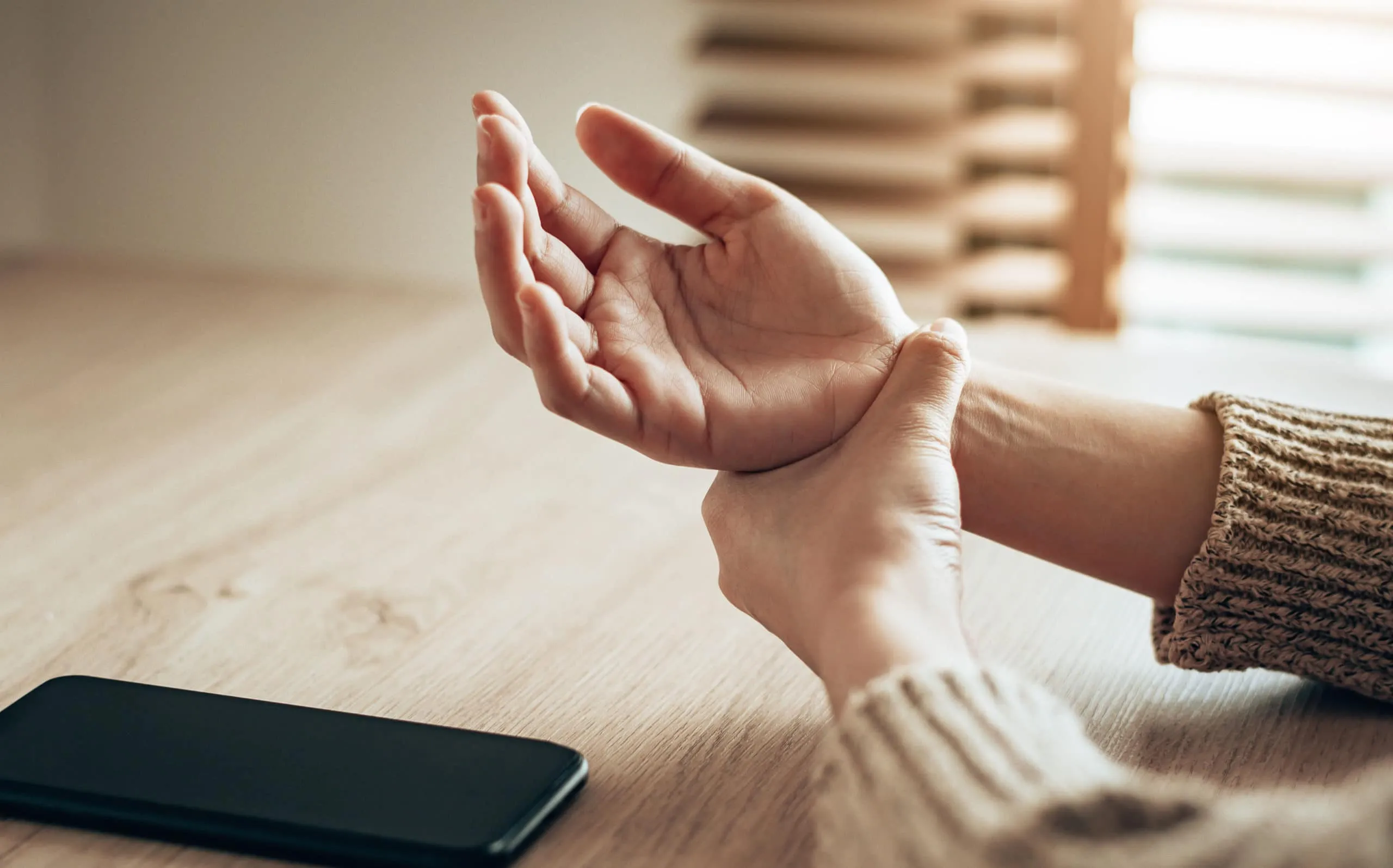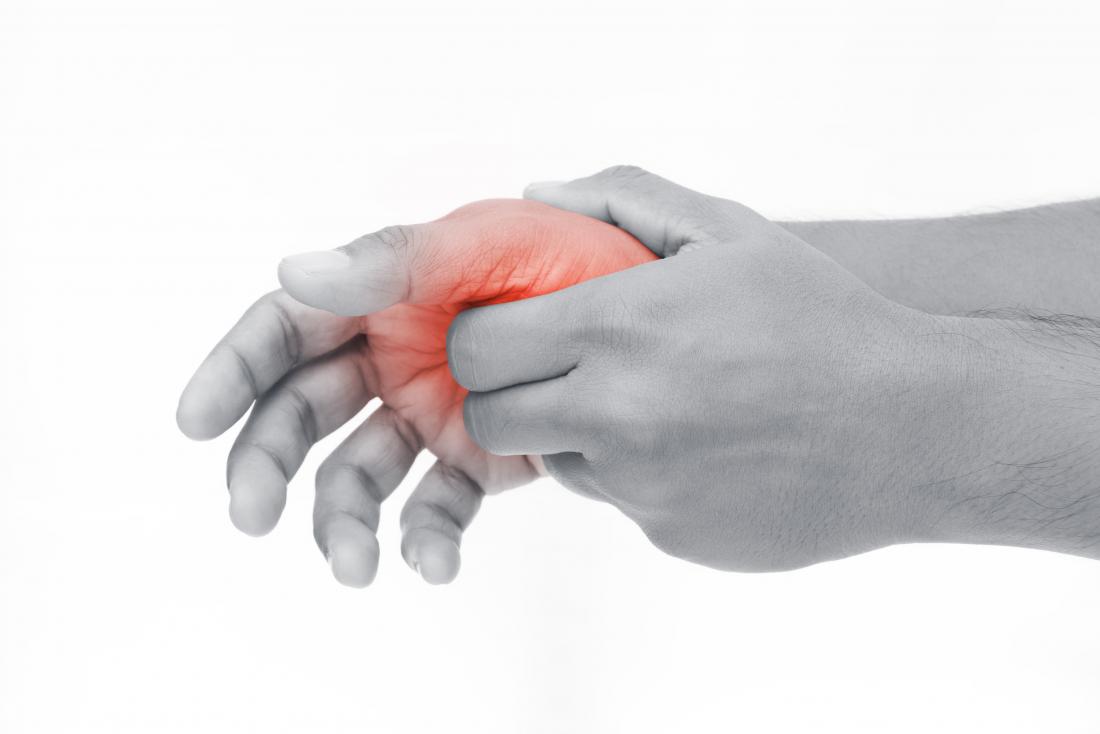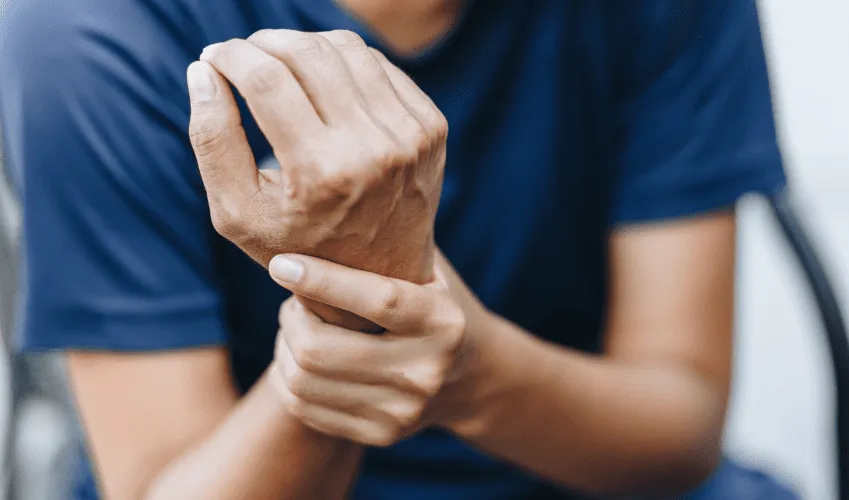Diagnosis and Treatment of de Quervain’s Tenosynovitis in Wake County

What is de Quervain’s Tenosynovitis (Wrist Tendonitis)?
Tendinosis refers to a swelling of the tendons. De Quervain’s tenosynovitis, or wrist tendonitis, occurs when the tendons around the base of the thumb are irritated or constricted, causing pain and tenderness along the thumb side of the wrist.
The two main tendons to the thumb pass through a tunnel located on the thumb side of the wrist. Tendons are rope-like structures that attach muscle to bone. A slippery, thin soft-tissue layer, called synovium, covers the tendons. This layer allows the tendons to slide easily through a fibrous tunnel called a sheath. Any swelling of the tendons or thickening of the sheath results in increased friction and pain with certain thumb and wrist movements.

Causes of Wrist Tendonitis
In most cases, de Quervain’s tenosynovitis is caused by overuse. However, it can also be associated with pregnancy and is sometimes seen in new mothers. Those with osteoarthritis of the thumb may also be more likely to develop de Quervain’s tenosynovitis.
Symptoms of Wrist Tendonitis
There are several symptoms you may notice if you are suffering from de Quervain’s tenosynovitis. If you notice any of the following issues affecting your hand or wrist, we encourage you to schedule an appointment with a Raleigh Orthopaedic hand and wrist specialist today. Seeking proper treatment for your condition or injury is key to being able to live your daily life comfortably. Symptoms of de Quervain’s tenosynovitis can include:
- Pain over the thumb side of the wrist
- Pain felt in the wrist that travels up the forearm
- Pain that worsens with movement of the wrist or when moving the thumb down or up
- Swelling over the thumb side of the wrist, sometimes accompanied by a fluid-filled cyst in the same area
- A catching or snapping sensation when moving the thumb
- Pain and swelling that makes it difficult to move the thumb and wrist
How is de Quervain’s Tenosynovitis Diagnosed?
To determine whether you have de Quervain’s tenosynovitis, your physician will talk to you about your medical history and when you started experiencing wrist pain. They will ask you to describe your symptoms, as well as what makes them better or worse. This is followed by a physical exam, where your physician will check your wrist for pain and range of motion. In some cases, X-rays may be utilized to rule out other conditions, such as osteoarthritis.

Treatment for de Quervain’s Tenosynovitis at Raleigh Orthopaedic
In most cases, de Quervain’s tenosynovitis can be successfully managed with nonsurgical treatment methods. At Raleigh Orthopaedic, we strive to help patients avoid surgery whenever possible, focusing on conservative treatment methods before considering surgery. Nonsurgical treatment techniques for de Quervain’s tenosynovitis include:
- Splinting
- Topical or oral anti-inflammatory medication
- Avoiding activities that cause pain and swelling
- Corticosteroid injections
- Physical therapy, infrared light, ultrasound, or iontophoresis
If symptoms do not respond to nonsurgical treatments and discomfort continues, your physician may recommend surgery. Surgery is required in less than 10 percent of cases. During surgery for de Quervain’s tenosynovitis, the surgeon makes a small incision at the thumb side of the wrist and removes the inflamed tissue over and around the tendons. This allows the tendons to glide more freely. Surgery for this condition is an outpatient procedure and is performed under local anesthesia or regional block with light sedation. Following your procedure, you will wear a light bandage over the surgical area.

Recovery after de Quervain’s Tenosynovitis Surgery
Most patients will fully recover from de Quervain’s tenosynovitis surgery within six to twelve weeks. It is important that the hand is kept immobile and elevated as much as possible during your recovery. Ice therapy may be recommended every one to two hours during the day for the first three days after surgery. The hand and wrist should not be used for any activities in the first one to two weeks after surgery. Your doctor may also advise you to take pain medication as needed.
Can de Quervain’s Tenosynovitis Be Prevented?
The best way to avoid de Quervain’s tenosynovitis is to prevent repetitive movements of the wrist. If you work or perform an activity where frequent wrist movement is necessary, it may be beneficial to switch up the way you perform the action to reduce stress on the wrists. If the movement cannot be avoided, it is important to take breaks to rest the wrists throughout the day. Talk to your healthcare provider if you are experiencing any sort of pain or numbness when performing certain activities.

Learn More About Hand and Wrist Treatment at Raleigh Orthopaedic
At Raleigh Orthopaedic, your orthopedic health and wellness is our main priority. If you are experiencing symptoms of an orthopedic condition or injury, whether it is affecting your wrist or elsewhere, we encourage you to schedule an appointment with one of our specialists today. We offer comprehensive orthopedic care and therapy services at several convenient locations throughout Wake County, and we want to help you get back to living and moving more comfortably. Contact us to schedule an appointment or book online today!




